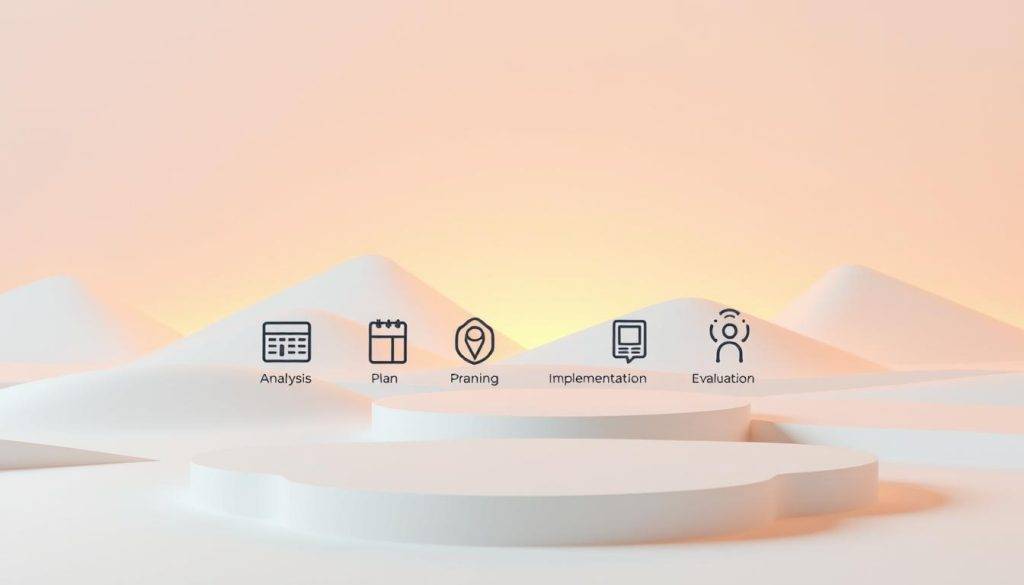“Progress is impossible without change, and those who cannot change their minds cannot change anything.” – George Bernard Shaw’s words cut to the heart of why overcoming obstacles matters. In a world where 70% of organizational changes fail due to human pushback (McKinsey & Company), understanding how to navigate challenges becomes critical for growth.
Whether striving for career advancement or personal breakthroughs, everyone encounters friction. Workplace dynamics often reveal visible symptoms like missed deadlines or low morale. On an individual level, self-doubt or stress can quietly sabotage progress. These patterns signal misalignment between actions and desired outcomes.
This guide bridges psychology and practicality. You’ll learn to recognize subtle forms of stagnation – from team conflicts to inner criticism – and transform them into stepping stones. Research shows traditional success strategies often overlook emotional barriers, while lasting change requires addressing both mindset and environment.
Key Takeaways
- 70% of organizational changes fail due to unaddressed human factors
- Resistance appears differently in professional teams vs personal journeys
- Emotional awareness creates sustainable progress toward goals
- Combining psychological insights with action plans yields better results
- Challenges become growth opportunities with the right tools
Establishing the Importance of Change
Every significant achievement in life begins with a willingness to step into the unknown. Modern workplaces now thrive on agility—high-performing teams in flatter organizations rely on specialized skills and adaptive thinking. Yet even motivated people often hesitate when facing shifts that disrupt routines or challenge familiar patterns.

Understanding the Impact on Personal Growth
Personal development stalls without new challenges. Embracing change acts like a muscle-building exercise for resilience—it strengthens problem-solving abilities and sharpens self-awareness. Those who avoid transitions often remain stuck in outdated habits, while growth-minded individuals use uncertainty as fuel for reinvention.
The Role of Change in Professional Success
Adaptability now ranks among the top skills employers seek. Professionals who welcome new systems or strategies typically achieve better outcomes—they’re 42% more likely to earn promotions according to LinkedIn data. Organizations increasingly reward employees who view workplace evolution as an opportunity rather than a threat.
Resistance often hides beneath surface-level concerns about time management or workflow. By addressing these fears proactively, individuals transform barriers into stepping stones. The choice becomes clear: cling to comfort zones or unlock new levels of achievement through strategic adaptation.
Understanding Employee and Personal Resistance
Organizations and individuals often face invisible walls when pursuing growth. Whether adapting to new technologies or personal goals, resistance emerges from both logical concerns and deep-seated emotions. Recognizing these patterns requires looking beyond surface-level behaviors to uncover hidden drivers.
Common Causes of Resistance
Employee resistance frequently stems from practical worries. People might fear unfamiliar processes or doubt their ability to master new skills. Concerns about job security or reduced autonomy often amplify these feelings. When teams lack clear communication about changes, uncertainty grows like weeds in untended soil.

The Emotional and Psychological Aspects
Behind every “no” lies a web of emotions. Anxiety about failure or anger over disrupted routines can paralyze progress. Holding patterns—repeated negative thoughts—keep people circling the same problems. Deeply rooted beliefs like “I don’t deserve success” or “Change always backfires” act as silent saboteurs.
Employees may express rational concerns about workflow adjustments while subconsciously reacting to past disappointments. Leaders who address both layers—practical needs and emotional triggers—build bridges where others see barriers. By acknowledging fears without judgment, you create space for genuine transformation.
Identifying the Root Causes of Resistance
Why do smart people sometimes block their own progress? Kotter and Schlesinger’s research reveals four hidden triggers that stall growth. These patterns operate like silent software bugs—unseen but powerful enough to crash entire systems.

Analyzing Self-Interest and Trust Issues
Self-interest often drives behavior more than logic. Employees might resist process changes fearing reduced influence, while individuals avoid personal growth steps that challenge their identity. This “what’s in it for me” mindset creates invisible walls.
Trust gaps magnify these challenges. Teams with fractured relationships hear proposed changes through filters of past disappointments. A manager’s well-intended strategy might register as “another unrealistic demand” if credibility isn’t established first.
Consider these hidden dynamics:
- Different access to information creates conflicting views of change impacts
- Past failures shape assumptions about future success rates
- Personality traits influence adaptability thresholds
Leaders who spot these patterns can customize solutions. For example, addressing promotion fears during restructuring or providing skill-building resources for anxious team members. The key lies in diagnosing why people hesitate, not just reacting to their objections.
Removing Resistance
Transforming challenges into opportunities requires more than willpower—it demands strategic redirection of energy. The fastest path forward often lies in shifting focus from obstacles to momentum-building actions. This approach helps dissolve opposition through empowered choices rather than direct confrontation.

A How-To Approach for Immediate Action
Begin by acknowledging resistance as a natural response to change. Instead of battling it, redirect attention toward positive emotional states. The “get off the subject” technique works like mental aikido—using present-moment contentment to dissolve barriers.
| Strategy | Action | Benefit |
|---|---|---|
| Perspective Shift | Identify 3 current wins | Builds solution-focused mindset |
| Energy Redirection | Replace “why not” with “how might we” | Creates forward momentum |
| Flow State Activation | Schedule 15-minute creative bursts | Reduces overthinking patterns |
These methods help transition from forceful pushing to organic growth. By focusing on what feels achievable now, you create psychological space for breakthroughs. The table above outlines practical ways to implement this philosophy.
True transformation occurs when we stop treating resistance as an enemy. Instead, view it as a signal to adjust strategies. This mindset turns perceived roadblocks into navigation tools for sustainable progress.
Communication, Participation, and Support Strategies
Building bridges through dialogue and collaboration transforms uncertainty into momentum. Successful change management relies on three pillars: clarity in messaging, inclusive decision-making, and accessible resources. When organizations address both logic and emotion, they create environments where growth becomes inevitable.

Effective Communication Methods to Reduce Fear
Transparency dismantles anxiety. Leaders who explain why changes matter—and how they’ll help employees thrive—build trust faster. Share timelines, benefits, and potential hurdles early. For example, hosting Q&A sessions before rollout lets teams voice concerns while feeling heard.
Encouraging Team Involvement and Collaboration
Participation turns bystanders into architects. Invite staff to co-design workflows or problem-solve during transitions. A tech company increased adoption rates by 65% when they let teams customize new software features. This approach fosters ownership and surfaces practical insights leaders might miss.
Building Support Systems and Guidance Channels
Ongoing assistance prevents backsliding. Develop mentorship programs and skill-building workshops alongside policy changes. Managers trained in emotional intelligence become better coaches—they spot unspoken worries and connect people to resources. Regular check-ins maintain momentum while adjusting strategies as needed.
One healthcare network reduced implementation delays by 40% using this triad approach. They paired clear updates with cross-departmental task forces and 24/7 coaching hotlines. When people feel informed, involved, and supported, resistance fades into renewed purpose.
Embracing Change in the Workplace
Prosci research reveals organizations with strong change cultures achieve 73% higher project success rates. Creating environments where teams embrace change requires intentional design—like cultivating fertile soil before planting seeds. This begins with psychological safety, where employees may feel empowered to voice concerns without fearing career repercussions.
Nurturing a Positive Change Culture
Forward-thinking companies treat adaptability as a core skill. They host “experimentation hours” where teams test new workflows risk-free. Google’s Project Aristotle found teams with high psychological safety outperform others by 17%—proof that comfort in vulnerability drives innovation.

Leader Roles and Visible Support
PwC’s global study shows 64% of employees trust change initiatives when executives actively participate. Leaders must model adaptability—like a retail CEO who learned inventory software alongside staff during a system overhaul. This hands-on approach builds credibility faster than memos.
Effective sponsorship involves three actions:
- Weekly town halls explaining the change process
- Cross-departmental “change champion” networks
- Public recognition for early adopters
When leaders consistently support change, it cascades through teams. A financial services firm increased transformation speed by 40% after training managers in growth mindset techniques. By creating a supportive environment, organizations turn mandatory shifts into collective momentum.
Managing Emotional Barriers and Psychological Blocks

Emotional awareness acts as a compass through mental fog. When facing transitions, 83% of professionals report physical symptoms like headaches or fatigue signaling deeper psychological blocks. These bodily cues often precede conscious recognition of hesitation.
Decoding the Language of Limiting Beliefs
Self-doubt thrives in vague emotional states. Expanding your feeling vocabulary—distinguishing apprehension from dread—helps dismantle fear’s power. Research shows naming emotions reduces their intensity by 30% through neural pathway changes.
The praise report technique transforms past wins into present courage. By documenting three previous successes whenever anxiety surfaces, you create counter-evidence to “I can’t” narratives. This method leverages proven neural plasticity—strengthening confidence pathways through deliberate focus.
Consider these patterns:
- Tight shoulders often mask fear of failure
- Procrastination frequently stems from perfectionism
- Irritability may signal unmet security needs
Understanding emotional roots fosters compassionate problem-solving. Instead of battling resistance, skilled navigators ask: “What protection is this reaction attempting to provide?” This reframe turns inner conflicts into collaborative dialogues rather than power struggles.
Psychological blocks dissolve fastest when met with curiosity. By honoring safety needs while gently expanding comfort zones, sustainable growth becomes possible. The journey transforms from forced compliance to empowered self-discovery.
Implementing Change: A Step-by-Step Guide
Effective transformation begins with a blueprint that turns vision into actionable steps. Organizations that master the change process see 58% higher success rates in achieving goals (Gartner). This approach combines structure with flexibility, creating pathways that adapt to real-world challenges while maintaining momentum.

Planning and Executing the Change Process
Start by mapping the “why” behind shifts to the “how” of implementation. Successful change initiatives involve teams in co-designing workflows—a tactic shown to reduce pushback by 34%. Break large objectives into sequenced steps, ensuring each phase builds confidence through visible progress.
Leaders should communicate through multiple channels: town halls for big-picture context, team huddles for role-specific impacts. A healthcare network improved adoption rates by 41% using this layered approach. Pair timelines with skill-building resources, creating safety nets for those navigating new processes.
Establishing Measurable Milestones
Progress thrives on clarity. Define success metrics that track both business outcomes and human factors—like survey scores measuring team confidence. A tech company uses biweekly “pulse checks” to identify support needs before challenges escalate.
Celebrate incremental wins publicly. Recognition reinforces positive behaviors and builds collective momentum. When a retail chain introduced milestone-based rewards, project completion rates jumped 27%. These actions transform abstract goals into tangible achievements, keeping teams aligned and motivated.
Remember: sustainable change balances structure with empathy. By blending strategic planning with ongoing support, you create environments where growth becomes inevitable rather than imposed.
Assessing Outcomes and Refining Strategies
True progress demands regular checkpoints and course corrections. Like skilled navigators adjusting sails to shifting winds, individuals and teams must evaluate what’s working—and what needs reinvention. Start by comparing current results to original measurable milestones. Did quarterly productivity targets align with new workflow systems? Has personal stress decreased since adopting mindfulness practices?
Feedback analysis transforms raw data into growth opportunities. Conduct anonymous surveys or one-on-one reviews to uncover hidden patterns. A marketing team discovered their CRM update caused 25% longer task completion—valuable insight that prompted interface redesign. Celebrate wins publicly while treating gaps as invitations to innovate.
Strategy refinement thrives on flexibility. When metrics plateau, pivot techniques without abandoning core goals. Tech leaders at Adobe increased project success rates by 18% through quarterly “innovation sprints” that tested new collaboration tools. This iterative approach keeps progress dynamic rather than rigid.
Remember: Growth isn’t linear. By blending disciplined assessment with creative problem-solving, you turn every outcome—expected or surprising—into fuel for lasting success. The journey continues long after initial goals are met, revealing new horizons for those willing to keep evolving.
FAQ
How does overcoming resistance contribute to personal growth?
Addressing barriers allows individuals to embrace new opportunities, develop resilience, and align actions with long-term goals. This fosters adaptability—a key driver of transformational outcomes in career and life.
What are common causes of resistance in professional settings?
Fear of failure, unclear expectations, and perceived threats to job security often trigger pushback. Misalignment between organizational goals and employee priorities amplifies these challenges.
How do trust issues impact willingness to embrace change?
Low trust in leadership or processes creates skepticism about proposed changes. Transparent communication and consistent follow-through rebuild confidence in new initiatives.
What immediate steps can reduce resistance to new processes?
Start with small, achievable wins to demonstrate value. Provide hands-on training and peer mentoring to ease transitions while celebrating early adopters to build momentum.
Which communication methods help lower anxiety during transitions?
Town halls with Q&A sessions, progress dashboards, and personalized feedback loops create clarity. Storytelling that connects changes to tangible benefits improves emotional buy-in.
Why is leadership visibility critical during organizational changes?
Leaders who actively model desired behaviors and address concerns directly reinforce commitment. Their engagement signals stability, reducing uncertainty that fuels resistance.
How can individuals address self-doubt when facing challenges?
Reframe obstacles as skill-building opportunities using evidence-based techniques like cognitive restructuring. Documenting past successes creates a tangible counter-narrative to fear.
What metrics indicate successful implementation of new strategies?
Track adoption rates, productivity trends, and feedback sentiment. Behavioral shifts—like voluntary participation in change initiatives—often precede measurable performance improvements.
How does participation influence acceptance of workplace changes?
Involving teams in solution design creates ownership. Collaborative problem-solving transforms skeptics into advocates by valuing their expertise in shaping outcomes.
When should organizations revisit their change management plans?
Regular check-ins at 30-, 60-, and 90-day intervals allow course corrections. Significant drops in engagement or workflow disruptions signal the need for strategic adjustments.




























































